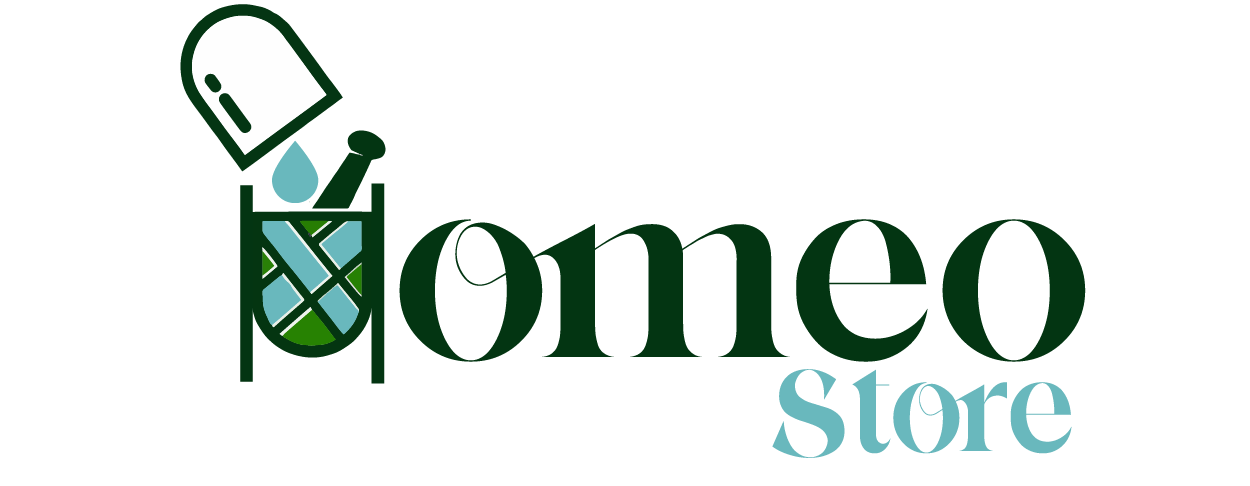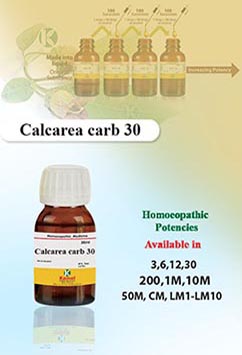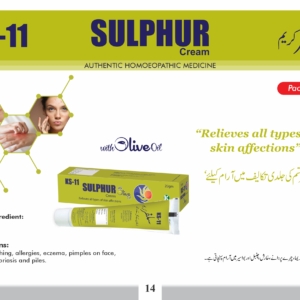Description
Indications / Symtoms : This great Hahnemannian anti-psoric is a constitutional remedy par excellence. Its chief action is centered in the vegetative sphere, impaired nutrition being the keynote of its action, the glands, skin, and bones, being instrumental in the changes wrought.
Description : Increased local and general perspiration, swelling of glands, scrofulous and rachitic conditions generally offer numerous opportunities for the exhibition of Calcarea. Incipient phthisis (Ars jod; Tuberculin). It covers the tickling cough, fleeting chest pains, nausea, acidity and dislike of fat. Gets out of breath easily. A jaded state, mental or physical, due to overwork. Abscesses in deep muscles; polypi and exostoses. Pituitary and thyroid disfunction.
Raised blood coagulability (Strontium). Is a definite stimulant to the periosteum. Is a hćmostatic and gives this power probably to the gelatine injections.
Easy relapses, interrupted convalescence. Persons of scrofulous type, who take cold easily, with increased mucous secretions, children who grow fat, are large-bellied, with large head, pale skin, chalky look, the so-called leuco-phlegmatic temperament; affections caused by working in water. Great sensitiveness to cold; partial sweats. Children crave eggs and eat dirt and other indigestible things; are prone to diarrhśa. Calcarea patient is fat, fair, flabby and perspiring and cold, damp and sour.
Mind.–Apprehensive; worse towards evening; fears loss of reason, misfortune, contagious diseases. Forgetful, confused, low-spirited. Anxiety with palpitation. Obstinacy; slight mental effort produces hot head. Averse to work or exertion.
Head.–Sense of weight on top of head. Headache, with cold hands and feet. Vertigo on ascending, and when turning head. Headache from overlifting, from mental exertion, with nausea. Head feels hot and heavy, with pale face. Icy coldness in, and on the head, especially right side. Open fontanelles; head enlarged; much perspiration, wets the pillow. Itching of the scalp. Scratches head on waking.
Eyes.–Sensitive to light. Lachrymation in open air and early in morning. Spots and ulcers on cornea. Lachrymal ducts closed from exposure to cold. Easy fatigue of eyes. Far sighted. Itching of lids, swollen, scurfy. Chronic dilatation of pupils. Cataract. Dimness of vision, as if looking through a mist. Lachrymal fistula; scrofulous ophthalmia.
Ears.–Throbbing; cracking in ears; stitches; pulsating pain as if something would press out. Deafness from working in water. Polypi which bleed easily. Scrofulous inflammation with muco-purulent otorrhśa, and enlarged glands. Perversions of hearing; hardness of hearing. Eruption on and behind ear (Petrol). Cracking noises in ear. Sensitive to cold about ears and neck.
Nose.–Dry, nostrils sore, ulcerated. Stoppage of nose, also with fetid, yellow discharge. Offensive odor in nose. Polypi; swelling at root of nose. Epistaxis. Coryza. Takes cold at every change of weather. Catarrhal symptoms with hunger; coryza alternates with colic.
Face.–Swelling of upper lip. Pale, with deep-seated eyes, surrounded by dark rings. Crusta lactea; itching, burning after washing. Submaxillary glands swollen. Goitre. Itching of pimples in whiskers. Pain from right mental foramen along lower jaw to ear.
Mouth.–Persistent sour taste. Mouth fills with sour water. Dryness of tongue at night. Bleeding of gums. Difficult and delayed dentition. Teeth ache; excited by current of air, anything cold or hot. Offensive smell from mouth. Burning pain at tip of tongue; worse, anything warm taken into stomach.
Throat.–Swelling of tonsils and submaxillary glands; stitches on swallowing. Hawking-up of mucus. Difficult swallowing. Goitre. Parotid fistula.
Stomach.–Aversion to meat, boiled things; craving for indigestible things-chalk, coal, pencils; also for eggs, salt and sweets. Milk disagrees. Frequent sour eructations; sour vomiting. Dislike of fat. Loss of appetite when overworked. Heartburn and loud belching. Cramps in stomach; worse, pressure, cold water. Ravenous hunger. Swelling over pit of stomach, like a saucer turned bottom up. Repugnance to hot food. Pain in epigastric region to touch. Thirst; longing for cold drinks. Aggravation while eating. Hyperchlorhydria (Phos).
Abdomen.–Sensitive to slightest pressure. Liver region painful when stooping. Cutting in abdomen; swollen abdomen. Incarcerated flatulence. Inguinal and mesenteric glands swollen and painful. Cannot bear tight clothing around the waist. Distention with hardness. Gall-stone colic. Increase of fat in abdomen. Umbilical hernia. Trembling; weakness, as if sprained. Children are late in learning to walk.
Stool.–Crawling and constriction in rectum. Stool large and hard (Bry); whitish, watery, sour. Prolapse ani, and burning, stinging hćmorrhoids. Diarrhśa of undigested, food, fetid, with ravenous appetite. Children’s diarrhśa. Constipation; stool at first hard, then pasty, then liquid.
Urine.–Dark, brown, sour, fetid, abundant, with white sediment, bloody. Irritable bladder. Enuresis (Use 30th, also Tuberculin. 1 m.).
Male.–Frequent emissions. Increased desire. Semen emitted too soon. Coition followed by weakness and irritability.
Female.–Before menses, headache, colic, chilliness and leucorrhśa. Cutting pains in uterus during menstruation. Menses too early, too profuse, too long, with vertigo, toothache and cold, damp feet; the least excitement causes their return. Uterus easily displaced. Leucorrhśa, milky (Sepia). Burning and itching of parts before and after menstruation; in little girls. Increased sexual desire; easy conception. Hot swelling breasts. Breasts tender and swollen before menses. Milk too abundant; disagreeable to child. Deficient lactation, with distended breasts in lymphatic women. Much sweat about external genitals. Sterility with copious menses. Uterine polypi.
Respiratory.–Tickling cough troublesome at night, dry and free expectoration in morning; cough when playing piano, or by eating. Persistent, irritating cough from arsenical wall paper (Clarke). Extreme dyspnśa. Painless hoarseness; worse in the morning. Expectoration only during the day; thick, yellow, sour mucus. Bloody expectoration; with sour sensation in chest. Suffocating spells; tightness, burning and soreness in chest; worse going upstairs or slightest ascent, must sit down. Sharp pains in chest from before backwards. Chest very sensitive to touch, percussion, or pressure. Longing for fresh air. Scanty, salty expectoration (Lyc).
Heart.–Palpitation at night and after eating. Palpitation with feeling of coldness, with restless oppression of chest; after suppressed eruption.
Back.–Pain as if sprained; can scarcely rise; from overlifting. Pain between shoulder-blades, impeding breathing. Rheumatism in lumbar region; weakness in small of back. Curvature of dorsal vertebrć. Nape of neck stiff and rigid. Renal colic.
Extremities.–Rheumatoid pains, as after exposure to wet. Sharp sticking, as if parts were wrenched or sprained. Cold, damp feet; feel as if damp stockings were worn. Cold knees cramps in calves. Sour foot-sweat. Weakness of extremities. Swelling of joints, especially knee. Burning of soles of feet. Sweat of hands. Arthritic nodosities. Soles of feet raw. Feet feel cold and dead at night. Old sprains. Tearing in muscles.
Sleep.–Ideas crowding in her mind prevent sleep. Horrid visions when opening eyes. Starts at every noise; fears that she will go crazy. Drowsy in early part of evening. Frequent waking at night. Same disagreeable idea always arouses from light slumber. Night terrors (Kali phos). Dreams of the dead.
Fever.–Chill at 2 pm begins internally in stomach region. Fever with sweat. Pulse full and frequent. Chilliness and heat. Partial sweats. Night sweats, especially on head, neck and chest. Hectic fever. Heat at night during menstruation, with restless sleep. Sweat over head in children, so that pillow becomes wet.
Skin.–Unhealthy; readily ulcerating; flaccid. Small wounds do not heal readily. Glands swollen. Nettle rash; better in cold air. Warts on face and hands. Petechial eruptions. Chilblains. Boils.
Modalities.–Worse, from exertion, mental or physical; ascending; cold in every form; water, washing, moist air, wet weather; during full moon; standing. Better, dry climate and weather; lying on painful side. Sneezing (pain in head and nape).
Relationship.–Antidotes: Camph; Ipec; Nit ac; Nux.
Dosage : Sixth trit. Thirtieth and higher potencies. Should not be repeated too frequently in elderly people
Group : Homoeopathic Potencies
Strength : 3,6, 12, 30, 200, 1000, 10M, 50M, CM, LM
Reference : HOMOEOPATHIC MATERIA MEDICA by William BOERICKE, M.D.







